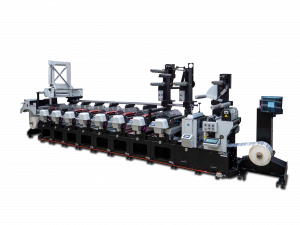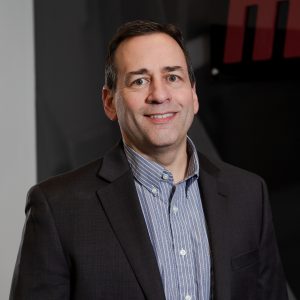Behind the scenes at Mark Andy – The technology at the forefront of narrow web printing and converting – Interview with Scott Warhover
In an exclusive interview, Scott Warhover, VP Engineering at Mark Andy Inc, talks with Nick Coombes about the development work that goes on to keep the company’s technology at the forefront of narrow web printing and converting.
NC: Please tell us about your job function and the work you do at Mark Andy
SW: I’m fortunate to be involved in many aspects of what we do at Mark Andy, including the team that focuses on the development of new products, and the team designing each custom machine that we build for our customers. Involvement in the design and technology decisions is a highlight of my job, along with managing our technology roadmap for future developments. We have an amazing engineering team here that really thrives on the toughest challenges.
NC: What drives the R&D at Mark Andy?
SW: For the process of developing new technology and machines, of course the objective is to help our customers become more successful. This requires a deep understanding of their needs and challenges, which of course can evolve over time. We work with Product Management and Sales to understand what our customers say they want. This can also involve looking beyond the immediate market situation to provide something they don’t even realize they need yet! That’s when the fun really starts for us – when the engineering team gets to brainstorm new ideas, weigh the benefits of each, design new concepts, and then build and test prototypes.
NC: How has this changed in the time you have been here and what are the major influences?
SW: Converters today have a far higher expectation of the technology and its capabilities – high performance is a given, but this now comes with an increased interest in sustainability.
Both short-term and long-term market trends drive our work. Long-term industry trends are the most difficult but critical to observe and predict, as they have the greatest impact on our developments. That said, we must remain flexible enough to allow our customers to thrive through short-term trends as well.
NC: Can you give us an example of this?
SW: Yes, one of the long-term trends we have all seen developing is towards shorter runs and more proliferation of label variants, personalization, and customization. While this has been influencing equipment development for several years, the shortages during Covid drove a short-term swing away from this, back towards fewer variants (SKUs). Our solutions need to allow our customers to push the limits of new trends, yet still adapt to these changes.
NC: What market trends are you noticing currently?
SW: The trend still driving the most change is the continued growth of digital printing in our market space. As with any shift in technology, there are a many new approaches fighting for a share of this market. I believe we will see this settle down somewhat in coming years as the most productive and profitable methods become established and accepted. Print speed, cost, and quality will continue to be the drivers here.
RFID in labels and packaging continues to see growth, and I believe this will continue for quite some time.
And, of course, owing to challenges in the work force and the global shortage of skilled personnel, everyone continues to experience the need for technology and automation to assist those operators with less experience.
NC: How is engineering development responding to these?
SW: There are two factors to a successful digital platform. As mentioned, the speed, cost and quality of the digital print is essential. But beyond that, the integration of the web transport and hybrid capabilities into these platforms is what transforms them into a complete and effective production tool. We are focusing on both.
We are also incorporating developments such as sMArtlink into our products. This allows all machines to produce and gather productivity data, as well as store this information, provide the tools to analyze this data, and communicate it effectively with customer ERP/MIS systems.
NC: To what extent do you work with converters and brand owners on the development of new technology, and how does this work in practice?
SW: This process is key to our product development process. Everything we do is downstream of identifying the needs obtained from the voice of the customer. We work closely with them, both directly and through product management and sales, to identify these needs.
One recent example is the Pro Series flexo platform we are currently launching. Some converters asked for an affordable full servo press. Others indicated they needed either entry or mid-market digital capabilities, with the possibility of hybrid configurations. We have taken this feedback, reviewed it in detail with the converters, and developed the first full flexo platform that can be built to run either left-to-right, or right-to-left, thereby fully enabling digital integration capabilities as well. This merging of our customers’ needs has led us to develop something new, something beyond the original target, which allows us to offer both a full flexo solution in the Pro Series press, and a new Digital Pro 3 and Digital Pro Max which offer improved digital productivity and flexibility.

NC: Where do you see narrow web flexo in the next five to 10 years?
SW: Narrow web flexo will continue as the high productivity mainstay of production throughout this time frame. Flexo continues to produce the lowest cost and highest speeds for long run work, and the greatest flexibility for materials and converting inline. Our Performance Series and Evolution Series presses remain at the forefront of our highest sales volumes, and we continue to develop flexo enhancements and new machines. Our belief in this is evident in the launch of our Pro Series flexo press this year.
NC: And where do you see digital in the same period?
SW: Digital continues to grow in this market space – we all see the cross-over point between digital and flexo continuing to rise. From a design standpoint we continue to work on increasing production speeds and lowering per-unit costs to drive this trend further. Variable data printing will continue to open new applications, and we will continue to see improvements in the integration of digital engines to further gains in productivity, user friendliness, and waste reduction.
NC: What, in your opinion, sets Mark Andy apart from its narrow web competitors?
SW: One thing that sets us apart is that we are truly not just a flexo company, or just a digital company. We are print. Given our ability to develop digital engines, and our ability to integrate digital engines, we do not see these as separate press developments from flexo. When a customer needs a machine, regardless of the printing technology, our processes are the same. This is a significant part of what makes us the Total Solution Partner to the industry. Beyond this, I will add that we thrive and excel at the most challenging applications and needs, regardless of the customization required. Our engineering team loves the challenge!